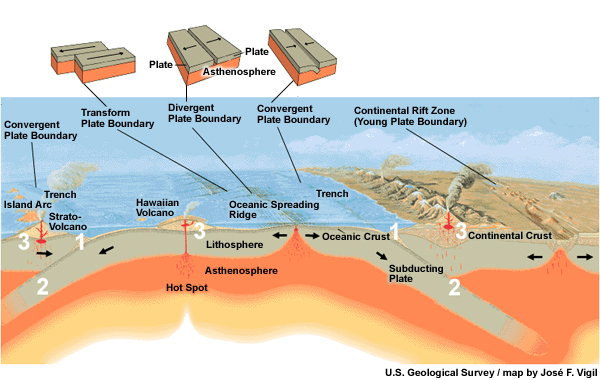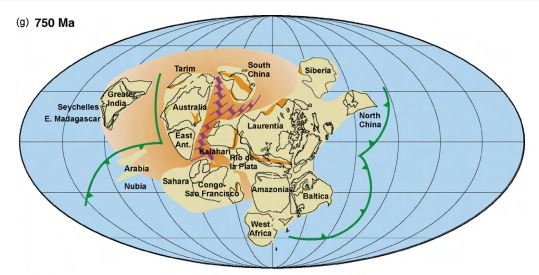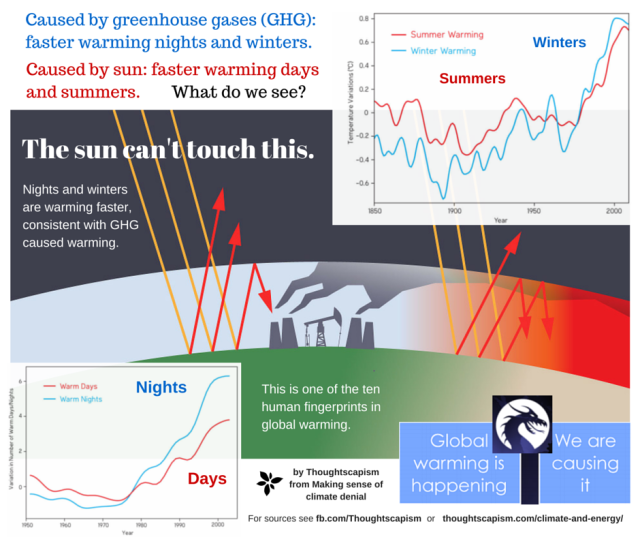About 700 – 800 MYA, during the Neoproterozoic era (in the late Precambrian), it has been proposed that the Supercontinent, Rodinia occupied an equatorial position on the Earth. Perhaps counter-intuitively, this tropical arrangement of the continents may have set the stage for a massive glaciation known as “Snowball Earth” during the Cryogenian period, despite equatorial regions receiving the most sunlight due to the orientation of the Earth with respect to the sun. Indeed, the fact that equatorial regions receive the most sunlight is part of the reason why tropical rainforest biomes exist where they do. So how could this have happened? Why would an equatorial continental arrangement render such a glaciation more likely? More on the Snowball Earth hypothesis in a moment: More generally however, what factors are capable of inducing changes in the climate?
There are several of them. First of all though, what do we mean by climate, and how does it differ from weather?
Weather refers to short term local fluctuations in temperature, precipitation, humidity, sunlight, atmospheric pressure, cloud cover and wind patterns, whereas climate refers to the average distribution of weather patterns over longer periods of time (usually decades or longer).
It’s no secret that average global temperatures have increased appreciably since the beginning of the industrial revolution. It’s a subject of endless and vehement political controversy, particularly surrounding the subject of anthropogenic causation via increased atmospheric concentrations greenhouse gases – primarily through the burning of fossil fuels – and what it might mean for policy makers.
Weather station temperature records, paleoclimatological data from ice cores and dendroclimatology (tree ring data), loss of Arctic glaciers and sea ice, and rising sea levels all converge on the conclusion that both land and sea surface temperatures have risen significantly in the last 150 years or so, and are breaking new records even as I type this.
I can delve into the current global warming phenomenon, its causes, why it’s considered a problem, and the public debate associated with it in a later post. Today however, I want to talk about something else. So for now, suffice it to say that global warming is expected to lead to broader climate change more generally. But we know that climate has changed naturally in the past, so what are the factors which can cause it?
There are several variables capable of changing earth’s climate, including the following: Plate tectonics (continental movement), changes in earth’s orbit (Milankovitch cycles), changes in solar output (sun spots and solar flares), volcanism, asteroid, comet and meteoroid impacts, as well as changes in the composition of the atmosphere (i.e. the greenhouse effect).
Plate Tectonics:
Plate tectonics is the scientific theory that the Earth’s outer shell consists of a network of rigid plates which glide slowly over the Earth’s mantle, interact with each other a various ways, and which are responsible for continental motion. The lithosphere includes the Earth’s rigid outer crust as well as the top layer of the mantle. The plates glide over the layer beneath that, a viscoelastic layer known as the asthenosphere, which is elastic and ductile under short term stress, and capable of convection and flow under long term stress. The motion of lithospheric plates results from a combination of influences such as gravity, convection currents and various forces associated with the rotation of the earth.
Tectonic plates can interact by pushing together along convergent boundaries, whereby one plate can slide beneath another other in a process called subduction. They can also pull apart at divergent boundaries; this is what occurs in seafloor spreading along oceanic ridges. They can also undergo lateral motion at what are called transform boundaries, which is when two adjacent plates slide past each other horizontally. Transform boundaries are usually associated with ocean floors where they offset the divergent sea floor spreading at ocean ridges. However, they can also occur on land, such as the San Andreas Fault in California, for example. In actuality, plates can also deform and interact in more complicated ways, but these are the Classical Plate Tectonics interactions covered in your typical 101 treatment.

U.S. Geological Survey/ map by Jose F. Vigil
Plate tectonics have been shaping the earth’s geography for billions of years via continental motion, and are responsible for the current layout of the continents (see these animated reconstructions here and here). Continental motion via the movement of tectonic plates can affect earth’s climate by changing the sizes and locations of both land masses and ice caps, and by altering ocean circulation patterns, which are responsible for transporting heat around the earth, which in turn affect atmospheric circulation processes. For instance, changes in continental area at higher latitude can lead to corresponding changes in the area of permanent ice cover, which can lead to what’s called ice-albedo feedback (or snow-albedo feedback). Earth’s albedo is simply the proportion of light from the sun that gets reflected back into the atmosphere. An albedo of 0 corresponds to a perfect black body (total light absorption), whereas an albedo of 1 corresponds to a perfect white body (total reflection).
So how does this relate to the Rodinia Supercontinent, and the Snowball Earth hypothesis? The idea here is that tropical continents reflect more light than Open Ocean, thus absorbing less heat. Today, by contrast, most of the heat is absorbed by the tropical oceans. Since the equator receives more sunlight than other latitudes, that means that a significant portion of incoming sunlight would have been reflected rather than absorbed.
Snow and ice have even higher albedos than rock and soil, so all that was needed was some sort of triggering mechanism to set a runaway ice age effect in motion: cooling leads to more snow and ice, which reflects more light, which leads to more cooling, which leads to more snow and ice, and so on and so forth.

Credit: MIT Artist concept of a planet-wide Ice Age on Earth. Credit: iStockphoto
I should mention that although the presence of glaciers during the Cryogenian is not disputed, the snowball earth hypothesis is far from settled science. There’s even a less extreme variant that has been dubbed the Slush Ball Earth hypothesis. Regardless of its details, or whether it’s even correct, the point of this section is that a tropical distribution of continents makes such a self-reinforcing feedback loop possible, and it serves as an example of what a dramatic effect continental positioning can have on climate change over the long term.
In part 2, I’ll finish up the Rodinia Supercontinent and Snowball Earth example by discussing candidates for a possible triggering mechanism that could have initiated such a reinforcing albedo feedback loop, and discuss how climate can be affected by perhaps a more familiar result of plate tectonics: mountain ranges.
References:
CNRS (Délégation Paris Michel-Ange). (2011, October 12). ‘Snowball Earth’ hypothesis challenged. ScienceDaily. Retrieved October 2, 2016 from
Fairchild, I. J., & Kennedy, M. J. (2007). Neoproterozoic glaciation in the Earth System. Journal of the Geological Society, 164(5), 895-921.
Hoffman, P. F. (2005). 28th DeBeers Alex. Du Toit Memorial Lecture, 2004. On Cryogenian (Neoproterozoic) ice-sheet dynamics and the limitations of the glacial sedimentary record. South African Journal of Geology, 108(4), 557-577.
Jacobsen, S. B. (2001). Earth science: Gas hydrates and deglaciations.Nature, 412(6848), 691-693.
Li, Z. and Bogdanova, S. and Collins, A. and Davidson, A. and De Waele, B. and Ernst, R. and Fitzsimons, I. et al. 2008. Assembly, configuration, and break-up history of Rodinia: A synthesis. Precambrian Research. 160: pp. 179-210.
Riguzzi, F., et al., Can Earth’s rotation and tidal despinning drive plate tectonics? Tectonophysics (2009).
Tsvetsinskaya, E. A., C. B. Schaaf, F. Gao, A. H. Strahler, R. E. Dickinson, X. Zeng, and W. Lucht, Relating MODIS derived surface albedo to soils and landforms over Northern Africa and the Arabian peninsula, Geophys. Res. Lett.,29(9), doi:10.1029/2001GL014096, 2002.
Watson C.S., King M.A., White N.J., Church J.A., Legresy B., & Burgette R.J. (2015). Unabated global mean sea-level rise over the satellite altimeter era. Nature Climate Change,5(6), 565-568. doi:10.1038/nclimate2635




8 Comments
How Continental Drift affects Climate: Part II – Possible Snowball Earth Triggering Mechanisms + Regional Effects of Mountain Ranges – The Credible Hulk · October 5, 2016 at 9:37 am
[…] Part 1 of this article, I outlined some of the variables which can affect Earth’s climate, and gave a […]
Milankovitch Cycles and Climate: Part I – Axial Tilt and Precession – The Credible Hulk · October 10, 2016 at 10:10 am
[…] feedback), which I mentioned briefly in my article on how continental drift affects climate (here and […]
The Climatological effects of Volcanic Eruptions: The End Permian Extinction, the Toba Super-Volcano, and the Volcanic Explosivity Index – The Credible Hulk · October 19, 2016 at 12:17 pm
[…] my articles on plate tectonics and continental drift (here and here), I used the Rodinia Supercontinent and Snowball Earth hypothesis as an example of how […]
The Sun and Earth’s Climate: The Solar Cycle and the Maunder Minimum – The Credible Hulk · January 9, 2017 at 12:15 pm
[…] How Continental Drift affects Climate: Part I – Plate Tectonics, Albedo, and the SnowBall Earth Hy… […]
The Structure and Properties of the Sun – The Credible Hulk · January 11, 2017 at 1:23 pm
[…] How Continental Drift affects Climate: Part I – Plate Tectonics, Albedo, and the SnowBall Earth Hy… […]
The Solar Dynamo: The Physical Basis of the Solar Cycle and the Sun’s Magnetic Field – The Credible Hulk · January 12, 2017 at 10:19 am
[…] How Continental Drift affects Climate: Part I – Plate Tectonics, Albedo, and the SnowBall Earth Hy… […]
Mean Field Theory and Solar Dynamo Modeling – The Credible Hulk · January 16, 2017 at 3:15 am
[…] How Continental Drift affects Climate: Part I – Plate Tectonics, Albedo, and the SnowBall Earth Hy… […]
No, Solar Variations Can’t Account for the Current Global Warming Trend. Here’s Why: – The Credible Hulk · January 17, 2017 at 9:17 am
[…] How Continental Drift affects Climate: Part I – Plate Tectonics, Albedo, and the SnowBall Earth Hy… […]
Comments are closed.